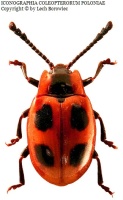
Русские, остановите эту войну! Спасите Свободную Украину!
Russians, stop this war! Save Free Ukraine!
Biodiversity Map
Taxa

Endomychus — subordinate taxa:
Taxon count: 2
-
Arthropodaphylum
Click to switch
to select orders
and filters > -
Hexapodasubphylum
Click to switch
to select orders
and filters > -
Insectaclass
Click to switch
to select orders
and filters > -
Coleopteraorder
Click to set
as the main taxon
and as a base
← of the left panel > -
Polyphagasuborder
Click to set
as the main taxon
and as a base
← of the left panel > -
Cucujiformiaseries
Click to set
as the main taxon
and as a base
← of the left panel > -
Cucujoideasuperfamily
Click to set
as the main taxon
and as a base
← of the left panel > -
Endomychidaefamily
Click to set
as the main taxon
and as a base
← of the left panel > -
Endomychinaesubfamily
Click to set
as the main taxon
and as a base
← of the left panel > -
Endomychusgenus
Click to set
as the main taxon
and as a base
← of the left panel >
PL
YES
name status: valid name
BioMap ID: 1019098
taxon code: 3556
taxonomy checked: YES
Data on distribution in Poland

Statistics
- Records: 155
- Publications: 50
- Collections: 11
- Publication authors: 53
- Illustrations (iconography): 1
- Photos (specimen/observation): 3
Taxon description
Pospolity gatunek w prawie całej Europie, w Fennoskandii docierający do skrajnych prowincji północnych, a w południowej części kontynentu częstszy w okolicach górzystych. W Polsce jest najczęściej spotykanym gatunkiem wygłodkowatych (Endomychidae) i choć nie jest jeszcze notowany z niektórych krain, występuje prawdopodobnie na całym obszarze. Zasiedla głównie stare drzewostany. Spotyka się go na martwym, przegrzybiałym drewnie pni i pniaków drzew liściastych, pod odstającą korą i na wyciekającym soku z drzew. Rozwój odbywa w grzybach nadrzewnych i hubach porastających głównie pieńki, na przykład wszystkie postacie rozwojowe znajdowano na wrośniaku szorstkim — Trametes hirsuta (Wulf. ex Fe.) Pill. Zarówno imagines, jak i larwy, występują przeważnie gromadnie, często obok siebie. Znajdowano je jesienią i wczesną, wiosną, dlatego należy sądzić, że te dwie postacie przezimowują.
Illustrations
... browse
 Endomychus
Endomychuscoccineus
External data sources
- Ostatnie rekordy
-
1141973
 ⊡
⊡ Endomychidae: Endomychus coccineus, PL, Nizina Mazowiecka, Nizina Środkowomazowiecka, Dolina Środkowej Wisły, mazowieckie, Warszawa, Warszawa, Zakole Wawerskie, UTM EC08, 2021, leg. M. Kochanowski
Endomychidae: Endomychus coccineus, PL, Nizina Mazowiecka, Nizina Środkowomazowiecka, Dolina Środkowej Wisły, mazowieckie, Warszawa, Warszawa, Zakole Wawerskie, UTM EC08, 2021, leg. M. Kochanowski -
1115814
 ⊡
⊡ Endomychidae: Endomychus coccineus, PL, Nizina Wielkopolsko-Kujawska, Pojezierze Lubuskie, Pojezierze Łagowskie, lubuskie, Zielona Góra, Sulechów, UTM WT46, 2020, leg. M. Adamski
Endomychidae: Endomychus coccineus, PL, Nizina Wielkopolsko-Kujawska, Pojezierze Lubuskie, Pojezierze Łagowskie, lubuskie, Zielona Góra, Sulechów, UTM WT46, 2020, leg. M. Adamski -
1104852
 ×
× Endomychidae: Endomychus coccineus, PL, Nizina Mazowiecka (Abraszewska-Kowalczyk et Kowalczyk 2002)
Endomychidae: Endomychus coccineus, PL, Nizina Mazowiecka (Abraszewska-Kowalczyk et Kowalczyk 2002) -
1074522
 ⊡
⊡ Endomychidae: Endomychus coccineus, PL, Puszcza Białowieska, podlaskie, hajnowski, ur. Hajduki, UTM FD84, 2015, leg. A. Lasoń
Endomychidae: Endomychus coccineus, PL, Puszcza Białowieska, podlaskie, hajnowski, ur. Hajduki, UTM FD84, 2015, leg. A. Lasoń -
1074521
 ⊡
⊡ Endomychidae: Endomychus coccineus, PL, Puszcza Białowieska, podlaskie, hajnowski, ur. Hajduki, UTM FD84, 2015, leg. A. Lasoń
Endomychidae: Endomychus coccineus, PL, Puszcza Białowieska, podlaskie, hajnowski, ur. Hajduki, UTM FD84, 2015, leg. A. Lasoń -
1074520
 ⊡
⊡ Endomychidae: Endomychus coccineus, PL, Puszcza Białowieska, podlaskie, hajnowski, ur. Hajduki, UTM FD84, 2015, leg. A. Lasoń
Endomychidae: Endomychus coccineus, PL, Puszcza Białowieska, podlaskie, hajnowski, ur. Hajduki, UTM FD84, 2015, leg. A. Lasoń -
1035353
 ⊡
⊡ Endomychidae: Endomychus coccineus, PL, Podlasie, P.K. Puszczy Knyszyńskiej im. profesora Witolda Sławińskiego, podlaskie, Sokółka, Krynki, UTM FD79, 2018, leg. K. Sućko
Endomychidae: Endomychus coccineus, PL, Podlasie, P.K. Puszczy Knyszyńskiej im. profesora Witolda Sławińskiego, podlaskie, Sokółka, Krynki, UTM FD79, 2018, leg. K. Sućko -
1031773
 ⊡
⊡ Endomychidae: Endomychus coccineus, PL, Wyżyna Małopolska, mazowieckie, Radom m., Radom, UTM EC00, 2018
Endomychidae: Endomychus coccineus, PL, Wyżyna Małopolska, mazowieckie, Radom m., Radom, UTM EC00, 2018 -
781480
 ⊡
⊡ Endomychidae: Endomychus coccineus, PL, Nizina Mazowiecka, mazowieckie, Urzut ad Nadarzyn, UTM DC86, 2010, leg. J. Tatur-Dytkowski
Endomychidae: Endomychus coccineus, PL, Nizina Mazowiecka, mazowieckie, Urzut ad Nadarzyn, UTM DC86, 2010, leg. J. Tatur-Dytkowski -
739502
 ×
× Endomychidae: Endomychus coccineus, PL (Rossa 1999(1998))
Endomychidae: Endomychus coccineus, PL (Rossa 1999(1998)) - ... more
- Powiązane publikacje
-
Plewa R., Jaworski T., Hilszczański J., Horák J. 2017a. Investigating the biodiversity of the forest strata: The importance of vertical stratification to the activity and development of saproxylic beetles in managed temperate deciduous forests. For. Ecol. Manage., 402:186-193.
 Show records
Show records -
Plewa R., Jaworski T., Hilszczański J. 2014b. Martwe drewno a jakościowa i ilościowa struktura chrząszczy (Coleoptera) saproksylicznych w drzewostanach dębowych. Studia i Materiały CEPL w Rogowie, 41(4):279-299.
 Show records
Show records -
Byk A. 2007. Waloryzacja lasów Gór Świętokrzyskich na podstawie struktury zgrupowań chrząszczy saproksylicznych. [In:] Borowski J., Mazur S. (Eds.) Waloryzacja ekosystemów leśnych Gór Świętokrzyskich metodą zooindykacyjną. Wydawnictwo SGGW, Warszawa. pp. 57-118.
 Show records
Show records -
Byk A., Mokrzycki T., Perliński S., Rutkiewicz A. 2006. Saproxylic beetles – in the monitoring of anthropogenic transformations of Białowieża Primeval Forest. [In:] Szujecki A. (Ed.) Zooindication-based monitoring of anthropogenic transformations in Białowieża Primeval Forest. Warsaw Agricultural University Press, Warsaw. pp. 325-397.
 Show records
Show records -
Byk A., Byk S. 2004. Chrząszcze saproksylofilne próchnowisk rezerwatu „Dęby w Krukach Pasłęckich”. Parki Nar. Rez. Przyr., 23(4):555-580.
 Show records
Show records - ... more









